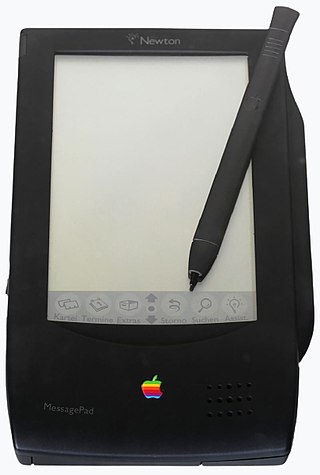
The MessagePad was a series of personal digital assistant devices developed by Apple Computer for the Newton platform in 1993. Some electronic engineering and the manufacture of Apple's MessagePad devices was undertaken in Japan by Sharp. The devices are based on the ARM 610 RISC processor and all featured handwriting recognition software and were developed and marketed by Apple. The devices run Newton OS.

The Amiga 1000, also known as the A1000, is the first personal computer released by Commodore International in the Amiga line. It combines the 16/32-bit Motorola 68000 CPU which was powerful by 1985 standards with one of the most advanced graphics and sound systems in its class. It runs a preemptive multitasking operating system that fits into 256 KB of read-only memory and was shipped with 256 KB of RAM. The primary memory can be expanded internally with a manufacturer-supplied 256 KB module for a total of 512 KB of RAM. Using the external slot the primary memory can be expanded up to 8.5 MB.
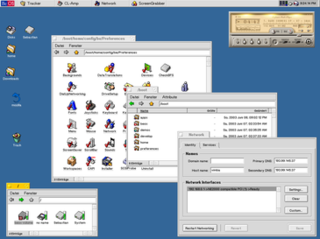
BeOS is a discontinued operating system for personal computers that was developed by Be Inc. It was conceived for the company's BeBox personal computer which was released in 1995. BeOS was designed for multitasking, multithreading, and a graphical user interface. The OS was later sold to OEMs, retail, and directly to users; its last version was released as freeware.
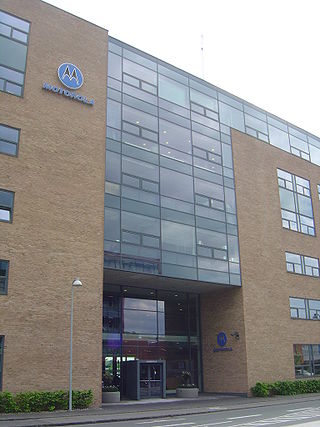
Motorola, Inc. was an American multinational telecommunications company based in Schaumburg, Illinois. It was founded in 1928 as Galvin Manufacturing Corporation by brothers Paul and Joseph Galvin. The company changed its name to Motorola in 1947. After having lost $4.3 billion from 2007 to 2009, Motorola was split into two independent public companies, Motorola Mobility and Motorola Solutions, on January 4, 2011. The reorganization was structured with Motorola Solutions legally succeeding Motorola, Inc., and Motorola Mobility being spun off.

PowerPC is a reduced instruction set computer (RISC) instruction set architecture (ISA) created by the 1991 Apple–IBM–Motorola alliance, known as AIM. PowerPC, as an evolving instruction set, has been named Power ISA since 2006, while the old name lives on as a trademark for some implementations of Power Architecture–based processors.

The RadioShack TRS-80 Color Computer, later marketed as the Tandy Color Computer and nicknamed the CoCo, is a line of home computers developed and sold by Tandy Corporation. Despite sharing a name with the earlier TRS-80, the Color Computer is a completely different, incompatible system and a radical departure in design and compatibility with its Motorola 6809E processor rather than the Zilog Z80 earlier models were built around.
Iridium Communications Inc. is a publicly traded American company headquartered in McLean, Virginia, United States. Iridium operates the Iridium satellite constellation, a system of 75 satellites: 66 are active satellites and the remaining nine function as in-orbit spares. Iridium Satellites are used for worldwide voice and data communication from handheld satellite phones, satellite messenger communication devices and integrated transceivers, as well as for two-way satellite messaging service from supported conventional mobile phones. The nearly polar orbit and communication between satellites via inter-satellite links provide global service availability.
File Allocation Table (FAT) is a file system developed for personal computers and was the default filesystem for MS-DOS and Windows 9x operating systems. Originally developed in 1977 for use on floppy disks, it was adapted for use on hard disks and other devices. The increase in disk drives capacity required three major variants: FAT12, FAT16 and FAT32. FAT was replaced with NTFS as the default file system on Microsoft operating systems starting with Windows XP. Nevertheless, FAT continues to be used on flash and other solid-state memory cards and modules, many portable and embedded devices because of its compatibility and ease of implementation.

Mail is an email client included by Apple Inc. with its operating systems macOS, iOS, iPadOS, watchOS, and visionOS. Mail grew out of NeXTMail, which was originally developed by NeXT as part of its NeXTSTEP operating system, after Apple's acquisition of NeXT in 1997.

Historically, the classic Mac OS used a form of memory management that has fallen out of favor in modern systems. Criticism of this approach was one of the key areas addressed by the change to Mac OS X.
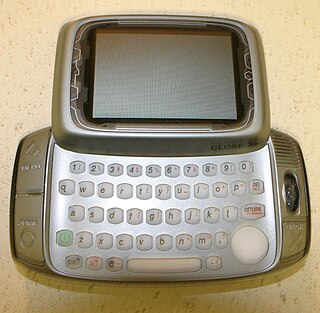
The Danger Hiptop, also re-branded as the T-Mobile Sidekick, Mobiflip and Sharp Jump, is a GPRS/EDGE/UMTS smartphone that was produced by Danger, Inc. from 2002 to 2010.

Newton OS is a discontinued operating system for the Apple Newton PDAs produced by Apple Computer, Inc. between 1993 and 1997. It was written entirely in C++ and trimmed to be low power consuming and use the available memory efficiently. Many applications were pre-installed in the ROM of the Newton to save on RAM and flash memory storage for user applications.
Lineo was a thin client and embedded systems company spun out of Caldera Thin Clients by 20 July 1999.
General Magic was an American software and electronics company co-founded by Bill Atkinson, Andy Hertzfeld, and Marc Porat. Based in Mountain View, California, the company developed precursors to "USB, software modems, small touchscreens, touchscreen controller ICs, ASICs, multimedia email, networked games, streaming TV, and early e-commerce notions." General Magic's main product was Magic Cap, the operating system used in 1994 by the Motorola Envoy and Sony's Magic Link PDA. It also introduced the programming language Telescript. After announcing it would cease operations in 2002, it was liquidated in 2004 with Paul Allen purchasing most of its patents.
The Motorola ROKR, the first version of which was informally known as the iTunes phone, was a series of mobile phones from Motorola, part of a 4LTR line developed before the spin out of Motorola Mobility. ROKR models were released starting in September 2005 and ending in 2009. They were notable for incorporating support of media player features.
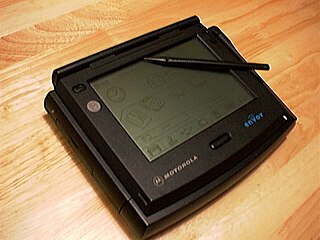
The Motorola Envoy Personal Wireless Communicator was a personal digital assistant initially slated for release by Motorola in summer 1994 but delayed and then available for public sale in February 1995. It was built to run General Magic's Magic CAP operating system, and it combined wireless, telephone, and infrared modems in a single PDA package. Andy Rubin led development of the Motorola Envoy.

The Newton is a series of personal digital assistants (PDAs) developed and marketed by Apple Computer, Inc. An early device in the PDA category, it was the first to feature handwriting recognition. Apple started developing the platform in 1987 and shipped the first devices in August 1993. Production officially ended on February 27, 1998. Newton devices ran on a proprietary operating system, Newton OS; examples include Apple's MessagePad series and the eMate 300, and other companies also released devices running on Newton OS. Most Newton devices were based on the ARM 610 RISC processor and all featured handwriting-based input.

The iPhone is the first iPhone model and the first smartphone designed and marketed by Apple Inc. After years of rumors and speculation, it was officially announced on January 9, 2007, and was released in the United States on June 29, 2007.

DR-WebSpyder is a DOS web browser, mail client and operating system runtime environment that was developed by Caldera UK in 1997. It was based on the DR-DOS operating system and networking components from Novell as well as the Arachne web browser by Michal Polák of xChaos software. The system was designed to run on low-end desktop systems, but being able to boot and execute from disk as well as from ROM or network, it was also tailored for x86-based thin clients and embedded systems with or without disk drives. Using the web browser as its principal user interface, it could be also used for kiosk systems and set-top boxes. It was ported to Linux in 1999 under the name Embrowser and was renamed Embedix Browser in 2000.














